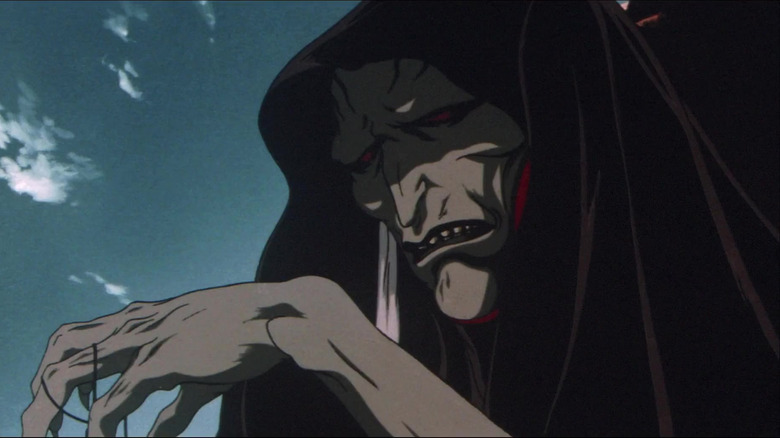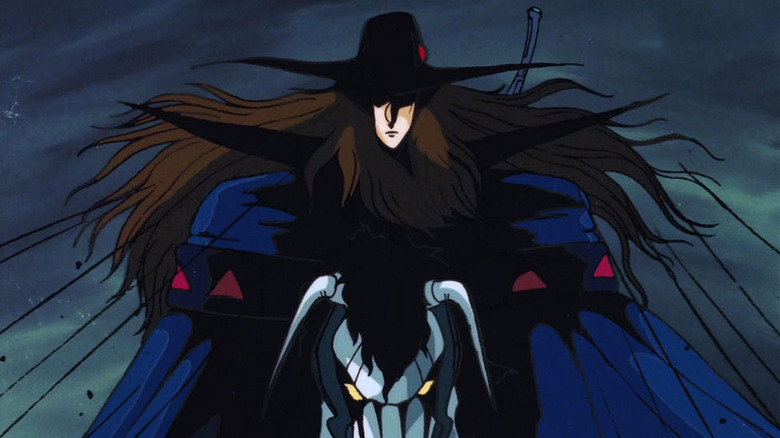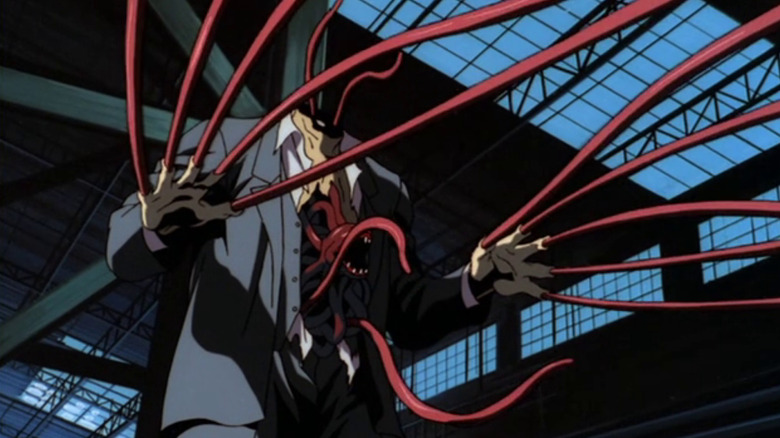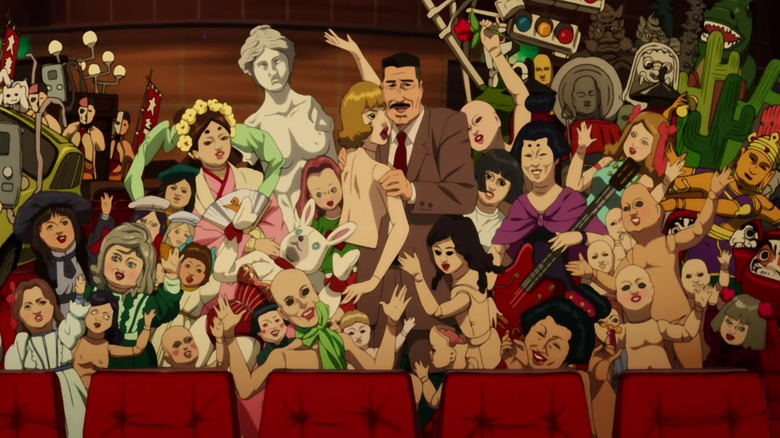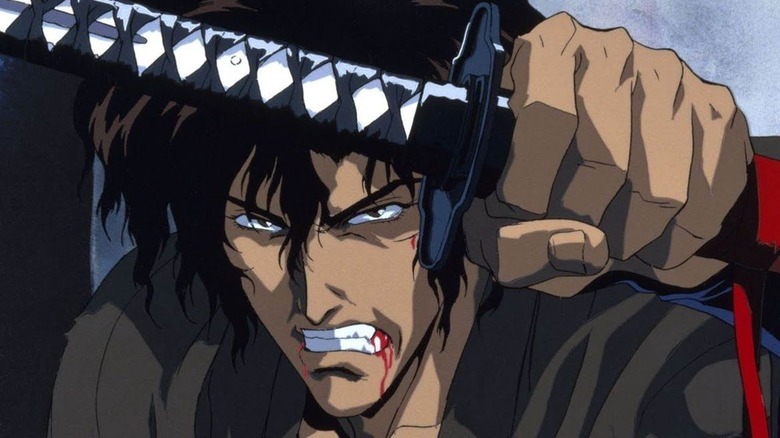15 Must-See Horror Anime Movies, Ranked
We may receive a commission on purchases made from links.
Creating terror with animation means that you aren't limited to our concept of reality. In anime, the body can be bent, stretched, and ripped apart using excruciating and fantastical methods that can only be realized via hand-drawn or computer-generated images. Films such as "Vampire Hunter D" and "Wicked City" realize horror anime's grotesque potential, creating hellish worlds where women become spider demons and eat men alive. Old tropes and well-tread creatures such as zombies are given facelifts and realized in new, repulsive ways that can't be replicated by actors in front of a camera.
There's going to be a lot of gore on this list of the best horror anime movies, especially from director Yoshiaki Kawajiri, who is known for his uncanny ability to create disgusting, sexual creatures with depraved desires. Animation lends itself perfectly to subgenre of body horror, after all. But that isn't all that the world of horror anime movies has to offer, as there are plenty of haunting ghost stories and psychological thrillers that will appeal to fans more interested in the supernatural side of the genre.
So let's dig into our list of some of the best horror anime movies out there.
15. Gyo: Tokyo Fish Attack (2012)
Manga artist Junji Ito is a master of creating horror on the page, authoring classic manga like "Uzumaki" and "Tomie." Then there's "Gyo," which was adapted into the anime film "Gyo: Tokyo Fish Attack," released in 2012 and directed by Takayuki Hirao. Yes, this is a tale about killer fish. But not just any killer fish — these aquatic creatures have mutated and grown legs. They also emanate a horrific and nauseating odor that is especially foul to protagonist Kaori, who has a particularly sensitive sense of smell.
The beginning of "Gyo" involves the invasion of a seaside Japanese town by the fish, led by a massive, walking great white shark. And it doesn't stop there. It's revealed that these fish are byproducts of Japanese experiments in biological warfare during World War II. "Gyo" is Ito at his wackiest and nastiest, and that tone is beautifully translated to the screen by Hirao. "Gyo" has something for everyone, especially lovers of horror comedy, aquatic horror, and body horror.
For more scary anime from this nightmare master, be sure to check out this line-up of adaptations of Ito's work.
14. Empire of Corpses (2015)
Gothic terror lovers, get ready, because "Empire of Corpses" is the horror anime movie for you. This 2015 film takes place in an alternate version of 18th century England. In this timeline, corpses are regularly reanimated using a technology called Necroware. They're then used as laborers; they don't think, feel, eat, or need to be paid. They're a perfect new labor force.
However, it's rumored that Victor Frankenstein has a machine that can reanimate not only bodies, but souls, too. These corpses would no longer be shells of people, but fully resurrected human beings. Scientist John Watson is chosen to go on an expedition to retrieve Frankenstein's notes and find a new way to bring back the dead.
"Empire of Corpses" is a quintessential steampunk adventure, full of homages to other prominent historical and literary figures, including "The Brothers Karamazov" and Colonel Frederick Burnaby. But it's also deeply emotional and upsetting, as Watson reflects on his own motivations for wanting to resurrect the dead and what it means for a corpse to have real autonomy over its body. "Empire of Corpses" deals with some downright chilling themes that provide a whole new perspective on the story of "Frankenstein."
13. King of Thorn (2010)
Released in 2010, "King of Thorn" is a gruesome blend of sci-fi and monster horror that is often referred to as "Sleeping Beauty" with a twist. It's another horror anime movie about a world ruined by a global pandemic, but this time people are suffering from the Medusa Virus, which essentially causes victims to turn to stone.
In a last-ditch effort to save humanity, 160 volunteers who have been diagnosed with the disease are placed in cold sleep while scientists develop a cure. But when they wake up, the facility is changed, covered in thorns and full of horrific creatures that immediately tear into the newly awakened group.
Only seven survive, and they must figure out what happened, what year it is, and how they can save the world. "King of Thorn" utilizes both 2D and 3D animation, which helps capture the scale of this world. The 2D work creates detailed characters, while the 3D work better illustrates the vast number of creatures and their seemingly impossible size. It makes "King of Thorn" feel big, and the characters' mission all the more futile.
12. Cat Soup (2001)
This animated short film by Tatsuo Satō is a surreal, trippy tale about grief and the deep bond between siblings, all represented by anthropomorphic cats. Nyatta is a young male cat who loves his older sister, Nyako, who is very sick. One day, while playing in the bath, Nyatta accidentally drowns and sees Nyako walking with Jizuo, the patron saint of dead children. He grabs her and, after a game of tug-of-war, they split Nyako's soul in half. When Nyatta is revived, he gives Nyako her soul back, but it is incomplete. So, they must embark on a journey through Hell to find the other half and make her whole again.
The short's gorgeous animation makes "Cat Soup" a contemplative sensory experience — there's no dialogue here to help guide the viewer through the story. Instead, it is up to the viewer to actively engage with "Cat Soup" and really fall into the journey alongside these two cats. But don't let that whimsical aesthetic fool you; "Cat Soup" is full of jarring imagery and violence, which is all the more shocking when it happens to animated cats.
11. Wicked City (1987)
Yoshiaki Kawajiri made his solo directorial debut with 1987's "Wicked City." The film takes place in a world where Earth and the demon-filled "Black World" have struck a tenuous peace treaty to maintain some semblance of order. The Black Guard, a special police force made up of humans and demons, makes sure the treaty is upheld. But that treaty is about to expire, and agents Taki, a human, and Makie, a demon, must protect the diplomat charged with its renewal. However, a radical group of demons don't want that to happen, and Taki and Makie must use their combined abilities to protect humanity from complete destruction.
Kawajiri used this film to show off his grotesque style and eye for shocking violence. With "Wicked City," he burst into the anime scene and established himself as a director with no qualms about breaking taboos. Women turn into spiders with monstrous vaginas; demons absorb humans into their flesh; creatures sprout rows of sharp teeth and tentacles; the body is merely a ball of clay for the animators to play with. Viewer beware: This is another hyper-sexual, hyper-violent joint that isn't for the faint of heart. But if you can handle extreme horror, "Wicked City" is worth seeking out.
10. Vampire Hunter D (1985)
There are two "Vampire Hunter D" films, and sadly, the original 1985 horror anime film is often overshadowed by its 2000 remake. But there's a lot of value to "Vampire Hunter D," including some gnarly monsters and death sequences that recall early Japanese animation. D is, in fact, a vampire hunter, but he's more than that; he's a dhampir, or a half-human, half-vampire. D wanders a post-nuclear landscape where vampire nobility, demons, and mutants rule the land. He's hired by Doris Lang to save her from Count Lee, a powerful vampire noble who wants to make her his new blood-sucking bride.
Begrudgingly, D takes on the assignment to save Doris from a tortuous fate, but it won't be easy. He must face a legion of monsters, each more powerful than the next. Did I mention that he also has a parasite in his left hand that manifests as a human face that keeps telling D to drink human blood? "Vampire Hunter D" was marketed as a "dark future science-fiction romance," and while there are moments of extreme gore, much of the film moves at a slow pace, focusing on building out the world's lore. That lore isn't always clear, but the film is still a visual feast for any gorehound.
9. Bio Hunter (1995)
Directed by Yoshiaki Kawajiri, the 1995 film "Bio Hunter" takes place in a world where a malady called the Demon Virus is ravaging Japan. Those infected with the virus transform into horrific creatures with a taste for human flesh. Human bodies are ripped to shreds and blood spurts from open throats.
In this hellscape, there are two men determined to stop the virus. Koshigaya and Kamada are two molecular-biologists-slash-demon-hunters who are trying to both develop a cure and also hunt down the infected. However, their journey takes a turn for the worse when Kamada contracts the virus. He uses the disease to his advantage, trying to keep his demonic side under control so that he can save as many lives as possible.
There's a reason that this isn't the only film by Kawajiri on this list — the prolific director is known for transgressive works that push the limits of the animated body. Teeth burst from flesh, bodies twist and mutate, and any semblance of humanity is stripped away. This hyper-sexual, hyper-violent horror anime proves that not all animated films are meant for children.
8. Memories (1995)
"Memories" is a sci-fi horror anthology from the mind of Katsuhiro Otomo, creator of the manga series "Akira." But this isn't just Otomo's project; it also comes from Satoshi Kon, Kōji Morimoto, and Tensai Okamura, all of whom had previously worked under Otomo.
The first story, "Magnetic Rose," is directed by Morimoto and written by Kon. It follows two engineers who discover an abandoned spaceship full of decadent furnishings and slowly unravel the mystery at the vessel's core. Next, there's "Stink Bomb," directed by Okamura and written by Otomo, about a man who takes the wrong pill and gives himself toxic farts. Yes, there is quite a tonal shift between stories.
Finally, there's "Cannon Fodder," directed and written by Otomo, about a young boy who dreams of becoming a military officer and firing cannons against a seemingly nonexistent enemy. These three unrelated films come together to create three very different imaginings of the future, and yet are united by gorgeous animation and thoughtful writing. The tales in this horror anime movie are psychologically scarring and purely haunting, focusing more on the cerebral experience of terror than visceral violence.
7. Demon City Shinjuku (1988)
In 1988, Yoshiaki Kawajiri gave the world another taste of his demon-obsessed style with "Demon City Shinjuku." While "Wicked City," "Ninja Scroll," and "Vampire Hunter D: Bloodlust" are Kawajiri's most well-known movies, this is an underrated gem that pumps the brakes on the gore and sexuality (don't worry, there are still a lot of creatures).
"Demon City Shinjuku" follows your typical hero's journey arc as a young man named Kyoya must save the universe from a powerful psychic named Rebi Ra. Ra killed Kyoya's father, and Kyoya seeks revenge as he prowls through a city full of demons. But Kyoya still hasn't discovered his powers' full potential, and he's running out of time to master his abilities. Along the way, the World President is bound to a giant crucifix by a supernatural plant and is going to be sacrificed to bring even more chaos to the world.
Like all of Kawajiri's work, "Demon City Shinjuku" is chock full of gorgeously choreographed action sequences that make up for its uneven pacing.
6. Seoul Station (2016)
Yeon Sang-ho's 2016 animated film "Seoul Station" is the official prequel to the Korean zombie hit "Train to Busan." It takes place right at the beginning of the zombie pandemic, as the disease is just spreading across the country. Hye-sun is sex worker living with her deadbeat boyfriend Ki-woong, who pimps her out for money. She's stuck in a vicious cycle of trauma and abuse, and is fed up with her life. After an explosive argument at the titular Seoul Station, the two are separated by a zombie outbreak. Meanwhile, Hye-sun's father Suk-gyu is searching the city for his estranged daughter and finally crosses paths with her boyfriend.
"Seoul Station" has a classic two-groups-split-up-during-a-zombie-attack structure, but it doesn't feel tired here due to the gorgeous animation and the political commentary about Korea's treatment of its unhoused population. Squatters are among the first victims of the virus, never taken seriously by authority figures and regarded as unimportant by society at large. While zombie films may be overdone, "Seoul Station" provides a breath of fresh air to a well-worn genre, particularly as it renders it through the lens of animation.
5. Vampire Hunter D: Bloodlust (2001)
With his 2001 film "Vampire Hunter D: Bloodlust," Yoshiaki Kawajiri revived the cinematic legacy of the vampire hunter named D. Here, D is hired after a young woman named Charlotte is abducted from her home by Baron Meier Link, a vampire nobleman. Charlotte's father pays D to find Charlotte and bring her back unscathed. Little does D know that he has competition, as her brother has hired the Marcus Brothers to get the job done. But nothing is what it seems, as it's revealed that Charlotte is actually in love with the vampire.
Kawajiri's "Vampire Hunter D" is more highly regarded than the 1985 film due to its improved pacing, action sequences, and animation style. It's been touted as one of the better vampire films, striking a balance between gore-filled action and character-driven moments that keep the viewer invested in the story.
4. Paprika (2006)
The last movie in Satoshi Kon's incredible filmography, 2006's "Paprika" is an incredible swan song from the legendary animator who died in 2010. Unlike "Perfect Blue," which features a psychological hellscape, "Paprika" is a psychedelic journey through dreams that addresses the terrifying malleability of the human mind, easily making it one of the best horror anime movies.
Dr. Atsuko Chiba is using a device called the DC Mini to illegally access the dreams of her psychiatric patients. By assuming her dream persona, Paprika, Chiba enters people's dreams to better analyze their subconscious. But, of course, such power is easily abused, and scientists with evil intentions steal the device and infiltrate unsuspecting minds, and manipulating people into killing themselves. Chiba dives into a world of colorful dreams to keep it all from oozing into the real world.
No written description can truly capture the jaw-dropping beauty of the film's animation, nor its reliance on dream logic (Kon isn't interested in making this film easy to understand). Christopher Nolan's 2010 "Inception" took quite a bit of inspiration from "Paprika," replicating a physics-defying hallway sequence and other pivotal scenes. But nothing compares to the power of animation. Kon rises to the challenge with this film, making something truly special.
3. Ninja Scroll (1993)
"Ninja Scroll" is Yoshiaki Kawajiri's most influential work, cited alongside "Akira" and "Ghost in the Shell" as one of the three films that brought adult-oriented anime to the West. Released in 1993, Kawajiri pivots from futuristic hellscapes full of demons to feudal Japan. Rest assured, though, there are still demons, this time eight very powerful ones called the Devils of Kimon, who want to overthrow the government.
Swordsman-for-hire Jubei, who wanders the countryside after a betrayal, is offered a large sum of money to learn more about these devils and uncover their motivations. Along the way, he pairs up with a female ninja named Kagero, the sole survivor of her clan. The two work together — and maybe fall in love — while saving the world from whatever dangerous plot lurks under the surface.
The action sequences in "Ninja Scroll" are lush and kinetic. Katanas slash across the screen and separate flesh from bodies in the blink of an eye. It's a visual feast, and much like the rest of Kawajiri's work, is packed with as much shocking sex and violence as possible.
2. Belladonna of Sadness (1973)
Eiichi Yamamoto's 1973 film "Belladonna of Sadness" is a heart-wrenching revenge masterpiece about a scorned woman who yearns for any type of control. In medieval France, Jeanne and Jean are newlyweds basking in the glow of a new marriage. However, it's sadly short lived when Jeanne is sexually assaulted by a baron in a ritual ceremony. Despite it being a tradition, Jean can't handle it and abandons Jeanne. In her despair, Jeanne is offered powers by a phallic demon who guarantees revenge on those who have wronged her.
What ensues is a never-ending struggle for Jeanne to regain bodily autonomy; her status as a woman damns her to a life of torture. Jeanne's body undergoes several transformations as she tries again and again to become a more powerful being, her flesh metamorphosing like a perverse butterfly. "Belladonna of Sadness" is an agonizing but strangely alluring watch thanks to psychedelic animation that represents violence against women in the abstract instead of in excruciating, realistic detail.
1. Perfect Blue (1997)
Satoshi Kon's feature directorial debut "Perfect Blue" is a horrifying psychological thriller about the effects of fame and obsession. The film, based on the novel of the same name by Yoshikazu Takeuchi, follows Mima Kirigoe, lead singer of the girl group CHAM!, which has a very dedicated fanbase. When Mima decides to move from singing to acting, fans are thrown into an uproar, constantly judging her choice on message boards. As Mima tries to cope with the backlash, as well as make it in the sleazy world of acting, she discovers that she has a stalker named Me-Mania and that someone is murdering those around her.
Between trying to maintain her persona as a grown-up female star and needing to process her trauma, Mima loses her grip on reality. She begins blacking out and can't remember where she was during the murders, making her a prime suspect. Her own concept of identity begins to slip away as she loses any concept of who Mima really is. "Perfect Blue" inspired movies like Darren Aronofsky's "Black Swan," providing a framework for examining modern obsession and their lasting psychological effects; this is not just about stalking, but about how your sense of self disappears when you step into the public eye.
If you're looking for more terrifying movies in animation, we've got a list of some of the best over here.
